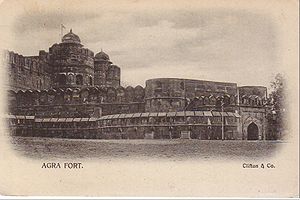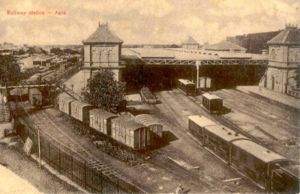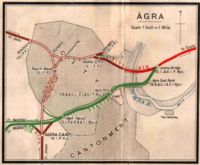| The Families In British India Society (FIBIS) is a self-help organisation devoted to members researching their British India family history and the background against which their ancestors led their lives in India under British rule. Let FIBIS help you break down those brick walls in your research |
Agra: Difference between revisions
Symorsebrown (talk | contribs) m Aypo |
Symorsebrown (talk | contribs) Amend summary, add external links |
||
| Line 11: | Line 11: | ||
{{Places of Interest|title=Agra |name=Agra |link=http://maps.google.com/maps/ms?msid=211401480495186034184.0004bb3163e856674d342&msa=0}} | {{Places of Interest|title=Agra |name=Agra |link=http://maps.google.com/maps/ms?msid=211401480495186034184.0004bb3163e856674d342&msa=0}} | ||
'''Agra''' was the headquarters of [http://dsal.uchicago.edu/reference/gazetteer/pager.html?objectid=DS405.1.I34_V05_081.gif Agra District] in the Agra Division of United Provinces during the British period. | |||
It is situated about 105 miles (170km) south-south-east of [[Delhi]]. As well as being the home of the Taj Mahal and the Agra Fort, Agra is an important railhead and junction. The ancient Mughal capital [[Fatehpur Sikri]] is to the south west of the city. | |||
== History == | == History == | ||
| Line 96: | Line 98: | ||
== External links == | == External links == | ||
*[http:// | *[http://dsal.uchicago.edu/reference/gazetteer/pager.html?objectid=DS405.1.I34_V05_090.gif Agra City] Imperial Gazetteer<br> | ||
*[http:// | *[http://www.1911encyclopedia.org/Agra Agra] Love to Know 1911 | ||
*This India List [http://archiver.rootsweb.ancestry.com/th/read/india/2009-03/1237825961 post] notes a researcher available in Agra, mentioned again in this [http://archiver.rootsweb.ancestry.com/th/read/india/2006-02/1140694934 post]. | *This India List [http://archiver.rootsweb.ancestry.com/th/read/india/2009-03/1237825961 post] notes a researcher available in Agra, mentioned again in this [http://archiver.rootsweb.ancestry.com/th/read/india/2006-02/1140694934 post]. | ||
*[http://www.dioceseofagra.org/contactUs.htm Diocese of Agra, Church of North India] Dioceseofagra.org | *[http://www.dioceseofagra.org/contactUs.htm Diocese of Agra, Church of North India] Dioceseofagra.org | ||
*This India List [http://archiver.rootsweb.ancestry.com/th/read/INDIA/2010-10/1286789133 post] advises that the baptism, marriage and burial records for St George’s Church (now the Cathedral) are kept at the Diocesan Office, near St Paul’s Church. | *This India List [http://archiver.rootsweb.ancestry.com/th/read/INDIA/2010-10/1286789133 post] advises that the baptism, marriage and burial records for St George’s Church (now the Cathedral) are kept at the Diocesan Office, near St Paul’s Church. | ||
===Historical books online=== | ====Historical books online==== | ||
*[http://www.archive.org/stream/handbooktoenglis00dewauoft#page/n3/mode/2up ''A hand-book to the English pre-mutiny records in the government record rooms of the United Provinces of Agra and Oudh''] by Douglas Dewar c 1919 Archive.org | *[http://www.archive.org/stream/handbooktoenglis00dewauoft#page/n3/mode/2up ''A hand-book to the English pre-mutiny records in the government record rooms of the United Provinces of Agra and Oudh''] by Douglas Dewar c 1919 Archive.org | ||
[[Category:Locations]] | [[Category:Locations]] | ||
[[Category:Cities, towns and villages in Bengal Presidency]] | [[Category:Cities, towns and villages in Bengal Presidency]] | ||
Revision as of 11:38, 25 June 2012
| Agra | |
|---|---|

| |
| Presidency: Bengal | |
| Coordinates: | 27.179700°N 78.021400°E |
| Altitude: | 171 m (561 ft) |
| Present Day Details | |
| Place Name: | Agra |
| State/Province: | Uttar Pradesh |
| Country: | India |
| Transport links | |
| Bombay, Baroda and Central India Railway East Indian Railway Great Indian Peninsula Railway | |
| FibiWiki Maps | |
|---|---|
| See our interactive map of this location showing places of interest during the British period | |
| Agra |
Agra was the headquarters of Agra District in the Agra Division of United Provinces during the British period.
It is situated about 105 miles (170km) south-south-east of Delhi. As well as being the home of the Taj Mahal and the Agra Fort, Agra is an important railhead and junction. The ancient Mughal capital Fatehpur Sikri is to the south west of the city.
History
Administration

The British took possession of Agra in 1803, and until 1829, the civil administration of the city was conducted by a Collector under the orders of the commissioners of the Ceded and Conquered Provinces. Between 1834 and 1836, Agra had its own Presidency, the Presidency of Agra, but this was abolished and the city was taken into the North-Western Provinces. The first Lieutenant-Governor installed there was Charles Metcalfe. Agra remained the seat of government for the province until 1858, when the administration was transferred to Allahabad. Ten years later, the High Court of Judicature followed.
In 1903, the North-Western Provinces were renamed the United Provinces of Agra and Oudh (United Provinces for short) and under independant Indian rule this province became Uttar Pradesh.
Military
- Battle of Agra 1803 in the 2nd Maratha War
- Retreat to Agra 1804 in the 2nd Maratha War
- Battle of Agra 1857 in the Indian Mutiny
Social
Over three quarters of a million people, mostly Indians, died during the Agra famine of 1837–38 that hit the North-Western Provinces.
Churches and missions

Anglican
- St George's, Cantonment - built 1828, consecrated 1835
- St John's Church, native church - built 1856, run by the Church Mission Society
- St Mathias's Church, Agra Fort
- St Paul's, Civil Lines - built 1855, run by the Church Mission Society
Roman Catholic
- RC Cathedral, Civil Lines - built 1848, the cathedral of the Archdiocese of Agra
- St Patrick's, Cantonment
Other denominations
- Havelock Memorial Chapel, Cantonment - run by the Baptist Mission, erected 1873 in memory of Sir Henry Havelock who, with the 13th Regiment of Foot, built a Baptist chapel in the Cantonment in 1837
- American Episcopal Methodist - by the District Courts, built 1887
Missions
- Church Mission Society, St John's College
- Baptist Mission
- Methodist Mission
Cemeteries
BACSA (British Association for Cemeteries in South Asia) cemetery publications are
- Agra Cantonment Cemetery by Robin Volkers, 2001 A record of over 5,000 burials from 1806-1990s, including all existing MIs, with plot diagrams indicating the shape and location of the tombs. 697pp, 106 illustrations and plans
- Agra St Paul's Cemetery by Robin Volkers, 2007 A record of burials from 1849-1958, monuments, wall tablets and inscriptions, including those at the nearby Tot ka Tal and Sikandra cemeteries. 102pp, 22 illustrations
BACSA have put the indexes to these cemetery books online and these indexes are free to browse. If an indexed name is of interest then application can be made to BACSA for details of the relevant burial inscription - charges apply for this service
Education
Colleges
- Agra College - founded in 1823 with an endowment from the East India Company
- St Peter's College - Roman Catholic institution, founded 1841 (wikipedia entry)
- St John's College - founded by the Church Mission Society in 1850 (wikipedia entry)
- Medical College - opened in 1855 for native hospital assistants
Schools
- Victoria High School - founded in 1862
- St George's High School for European children
- Convent school for girls
Orphanages
- The Roman Catholic Church ran two orphanages in Agra for European children, c 1857, St. Paul's for boys, and St. Patrick's for girls.[1]
Railways

Agra was an important rail head, served by the East Indian Railway, the Great Indian Peninsula Railway, and by both broad and metre gauge lines of the Bombay, Baroda and Central India Railway.
Stations

Agra has had a number of stations, the names of which changed over time. Many are no longer operational. Known stations are:
- Agra Cantonment (BB&CIR, GIPR) - (became Idgah) in the centre of the city, along the Fatehpur Sikri Road
- Agra City (EIR, GIPR) - in the northern part of the city
- Agra East Bank (BB&CIR, EIR) - on the opposite side of the river to the Fort
- Agra Fort (BB&CIR, EIR, GIPR) - next to the Fort
- Agra Jail - (became Bilochpura) in the North West of the city, by the District Jail
- Agra Junction - (became Jumna/Yamuna Bridge) on the right bank of the Jumna river
- Agra Road (GIPR) - (became Agra Cantt) to the south west of the cantonment, near the Sadar Bazaar
- Alumganj
- Belanganj (GIPR)
- Drummond Road
- Raja-ki-Mandi (GIPR) - in the northern part of the city
Maps
Agra and environs 1893 ancestry.com
References
- ↑ "Catholicity in India", page 394 The Rambler, Volume 7 1857 Google Books
External links
- Agra City Imperial Gazetteer
- Agra Love to Know 1911
- This India List post notes a researcher available in Agra, mentioned again in this post.
- Diocese of Agra, Church of North India Dioceseofagra.org
- This India List post advises that the baptism, marriage and burial records for St George’s Church (now the Cathedral) are kept at the Diocesan Office, near St Paul’s Church.
Historical books online
- A hand-book to the English pre-mutiny records in the government record rooms of the United Provinces of Agra and Oudh by Douglas Dewar c 1919 Archive.org